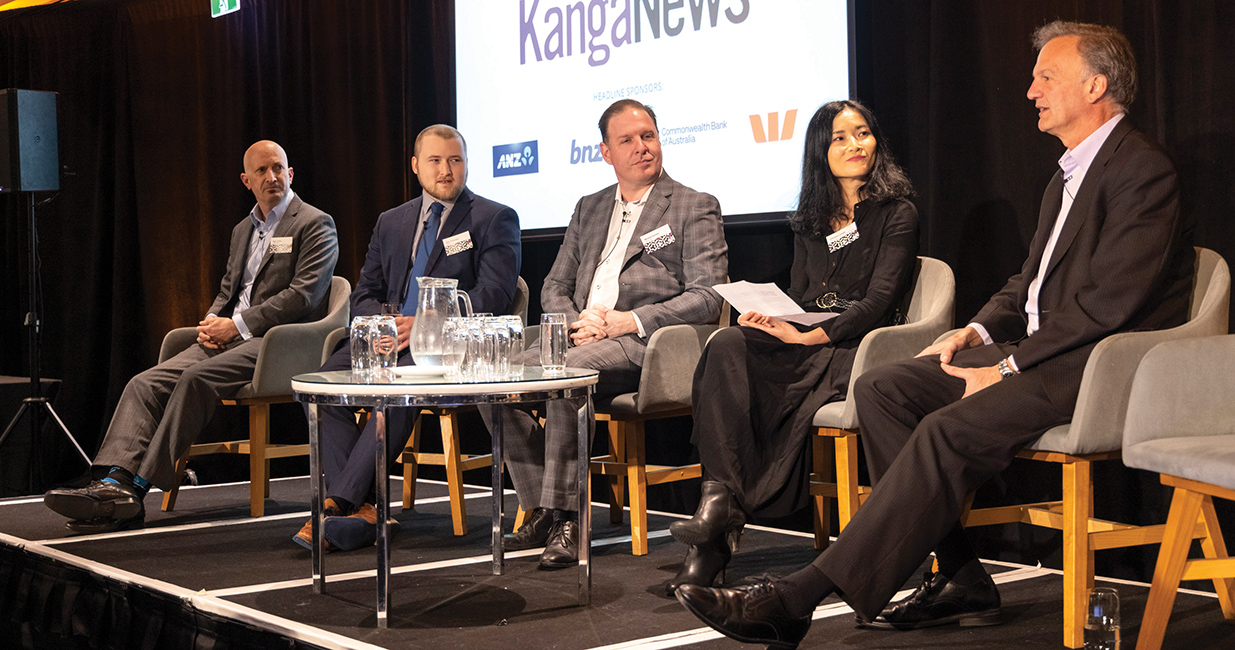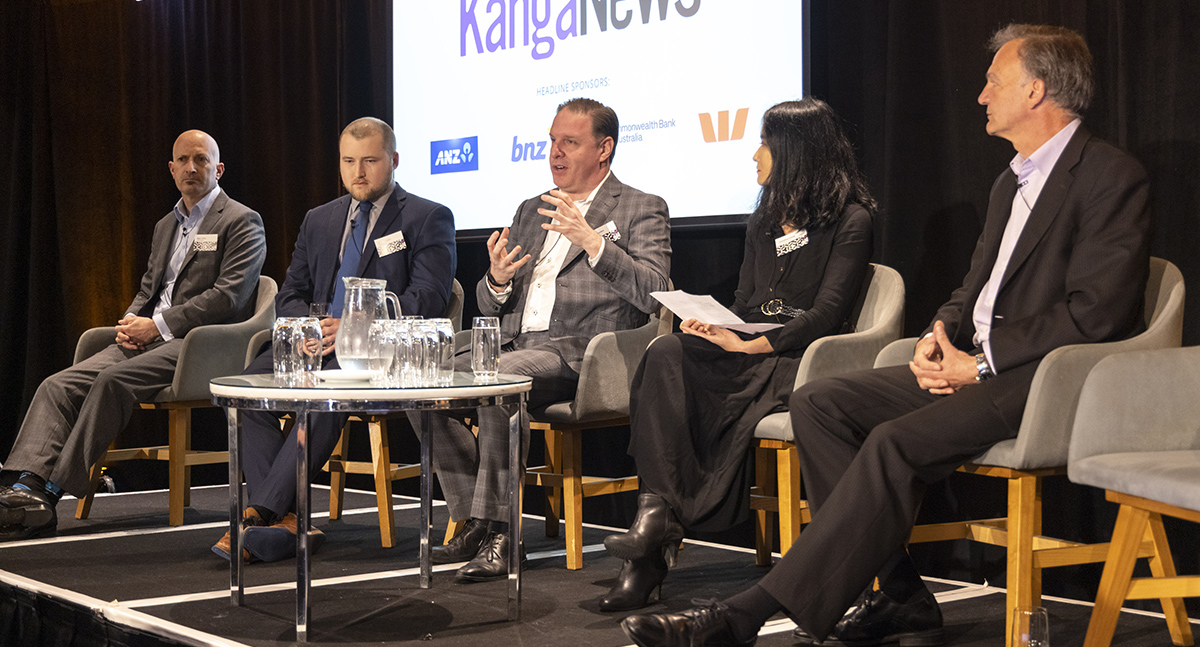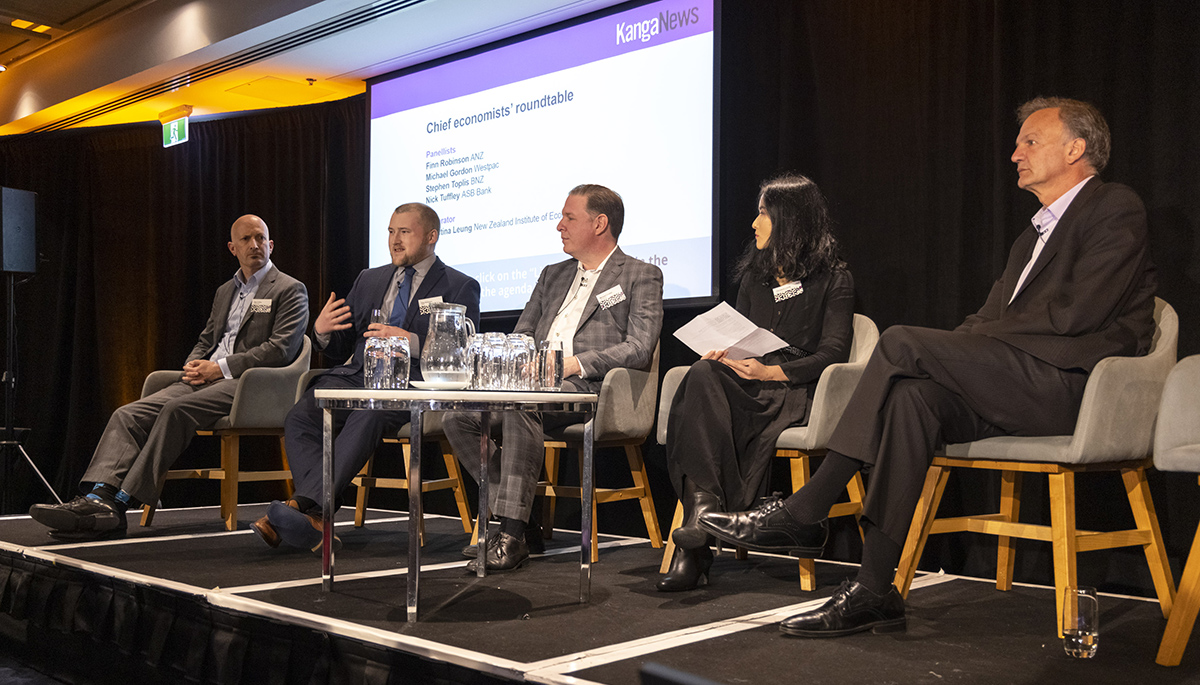
New Zealand on the front line in the global battle with inflation
The Reserve Bank of New Zealand was among the first globally to begin increasing rates and its battle with inflation goes on despite a series of hikes throughout 2022. The KangaNews New Zealand Debt Capital Market Summit gathered economists from the big-four banks to discuss the monetary policy response, political currents and the state of the local economy.
POLICY OUTLOOK
Leung How confident are you that central banks around the world will be able to get inflation under control and back within the target band?
TOPLIS The question should not be ‘whether’ central banks will get inflation down but how much damage they will do in the process and how long it will take. The stabilisation of housing and commodity markets will help decrease inflation quite quickly but the medium-term impact from labour markets is more uncertain.
ROBINSON Assuming central banks are allowed to do the job they have been assigned, they should be able to do it. They can more or less continue to lift the official cash rate (OCR) – or whatever policy rate they are using – until inflation is under control. It is a matter of how much they need to raise rates. We are currently forecasting the OCR to reach 4 per cent*, but when we look at how quickly wages are growing we wonder how much of a constraint there really is from mortgage rates. High inflation expectations are getting set into wage- and price-setting behaviour. The inflation ball is rolling and central banks need to get it sustainably within their targets. This will come at a cost to economic growth.
TUFFLEY Central banks only have one job, but the collateral damage along the way is uncertain. Fortunately, the RBNZ [Reserve Bank of New Zealand] is doing the heavy lifting now rather than in an election year. I suspect there will be a lot of awkward conversations next year about whether we are in a recession and, rightly or wrongly, there will be a lot of focus on the reserve bank.
GORDON Getting inflation off its highs should be easy enough, but the challenge will be what level it comes down to. Central banks have the tools and mandates to do what is needed: it is not as if they need to worry about the zero lower bound on interest rates, so they have all the room they need to do their job.
My background worry is central bank independence – or the potential for it to be undermined. Central banks are given a goal and left to figure out the best way to achieve it. But elected governments set this goal, and they can change it if it becomes politically inconvenient. Right now, it would be easy for governments to scapegoat central banks by saying they caused the inflation and now they are going to cause a recession to fix their mistake – so they need to be restrained.
Some central banks are more at risk of this than others. The RBNZ is better placed, but the Bank of England could be in danger. It is a tough time for central banks, reputation wise, and I’m not sure all the big ones will come out of this intact.
Leung Central banks have been rapidly increasing interest rates and one of the effects is yield curve inversion. How high will rates go and what are the implications for the global economy?
ROBINSON We forecast the OCR will reach 4 per cent by the end of the year. Given we were at 0.25 per cent at the end of 2021, this is an incredibly rapid increase. Considering where mortgage rates were in mid-2021, we are well past the trough and we are getting to the point where households will start to feel the effects of monetary policy tightening.
The questions are for how long the reserve bank will need to keep the OCR at 4 per cent and whether it will have to go further. High inflation has become embedded in the economy, and the last time it was similarly high and the unemployment rate was so low, the OCR was around 8.25 per cent. What will stop it getting to that level again and how high will it need to go?
If labour market indicators hold up, job ads remain solid and business confidence and activity expectations rebound, it would demonstrate that the economy is more resilient to hikes than expected.
Either way, we think the RBNZ will keep the OCR at a restrictive level for some time because of how persistent inflationary pressures are. We do not expect the OCR to be cut for a couple of years and think it will be a similar story overseas.
We expect the Fed [US Federal Reserve] will lift the federal funds rate to a peak of 4 per cent** and leave it there for all of 2023. The US also has an overstimulated, capacity-constrained economy with two job openings for every unemployed person. Core inflation is persistent and will take a long time to come out of the economy. Inflation will drop quickly over the next couple of quarters, but it will be high for a long period.
The yield curve suggests markets expect interest rates will start coming off around the middle of 2023. We think this is a little optimistic. Inflation is so persistent that it will take a long time to get back to a comfortable level.

TOPLIS To add to this, the majority of interest rate increases are now priced in. Nobody thinks we will go another 300 basis points from here – fingers crossed. Having said this, there is clearly more capacity to hike. We are not on top of inflation or the labour market and central banks will keep raising rates until they become comfortable this is the case.
At the moment, things seem to be stabilising better than anticipated. But even if this remains the case inflation will not disappear quickly, so the risk for rates is to the upside. I wouldn’t be surprised if the RBNZ goes through 5 per cent.
The shape of the yield curve is a bit tautological. If one believes interest rates are above neutral, the yield curve will be inverted because eventually we have to assume rates will come back down. The debate is where the inversion occurs, not whether or not it is inverted.
In New Zealand’s case, it is more problematic. Unlike in the US, where the yield curve tells us the likely shape of the economy going forward, in New Zealand it only tells us what the RBNZ is doing relative to the Fed.
Audience question What is the neutral rate?
GORDON To be determined. Taking a literal read on what the market thinks neutral is can give us whiplash as it has moved rapidly between 3 per cent and 4 per cent.
Current market pricing seems a little weird to me: the curve suggests the cash rate might get to 4.25 per cent before traveling back to 4 per cent and staying there for eternity. So is 4 per cent the neutral cash rate? Maybe, but there is no cycle priced into the market. Even though I think we can get inflation under control without needing a recession, even I am not optimistic enough to think inflation will come down without a cycle in interest rates. Either we will get to 4 per cent then go to something meaningfully lower in the long term or, if 4 per cent is what we can sustain in the long term, we might have to go to 5-7 per cent first.
What is priced into the market is inconsistent. A year from now the market might change its mind and decide 4 per cent is not the long-run level after all. It is difficult to get a handle on, especially when we are trying to think about long-term interest rates and where the 10-year rate will settle in a year’s time.
The RBNZ has had several goes at working out the neutral rate using half a dozen different methods. Taking the average, it is about 2 per cent. If there was a seventh method that was better than all the others, I would use it. But I don’t know of one, so we will work with 2 per cent for now.
“New Zealand has 56 occupations where people can come in and get instant residency. By contrast, Australia has more than 500 occupations where people can apply for fast-tracked residency after two years. They are driftnet fishing for migrants, whereas we have a guy from the immigration department standing on a rock with a worm on a hook.”
TOPLIS Why waste our time trying to work it out? Fundamentally, it doesn’t matter what any of us think the neutral rate is. The reserve bank sets policy according to what it thinks the rate is. Also, it is revised every year.
It wasn’t that long ago that the RBNZ thought the neutral rate was 4 per cent, and before that it was 6 per cent. It trends with interest rates and will go up from here.
TUFFLEY We thought it was around 2.5 per cent prior to COVID-19 – higher than the reserve bank has been thinking. In the longer term, who knows. One of the reasons it was trending down was because of changing demographics and savings patterns – and we may well see it descend again once we get through this high inflation, high interest rate period.
The other thing is that, for the moment, real interest rates are rather low. The sorts of things we look at from a nominal perspective are always interesting, but when we look at it in real terms we can get a very different picture in times like this.
ROBINSON Whatever the neutral rate was pre-COVID-19, it is probably higher now. This is clear from the way inflation expectations have increased, and wage and price settings have more explicitly factored in not just what has happened to inflation but what is expected to happen.
Whether or not we can get a neat expectation for neutral, the fact is everyone is adjusting to a higher rate environment – which raises the risk that a 4 per cent OCR is not as restrictive as expected. We see the risk that neutral is higher but, then again, the RBNZ is the expert. We eagerly await its update.
GOVERNMENT RESPONSE
Leung What is the role of government in a high inflation environment?
ROBINSON High inflation puts governments in a difficult position. We have gone through a period where fiscal support was very important in getting the economy through COVID-19. The question now is whether, and how much, governments here and overseas will rein in their spending from extremely elevated levels.
There seems to have been a change in psychology. Usually the idea is that governments don’t spend as much money when the economy is booming so they can build up fiscal buffers for the next crisis. But there has been an increased willingness to keep spending. For instance, the UK has a new government that seems quite willing to get out the chequebook and cut taxes, even if the economy is capacity constrained and the government is highly indebted.
The extent to which governments are not as restrained as they were previously will be a challenge for inflation. Economics 101 tells us that if the economy is highly capacity constrained – like the economies of most of our key trading partners – adding demand requires higher interest rates to offset that demand. This crowds out private spending.
In the near term, the challenge is capacity restraints and how we get inflation down. But there are also long-term challenges around climate change and health. Governments need to think about where they can target spending most effectively to get the best bang for their buck. They need to be careful not to make the inflation problem worse, because at the end of the day this would require higher interest rates than otherwise.
GORDON What governments should do about inflation is let central banks do their job. They are given the tools to do it. They are the ones with the monopoly over the supply of base money, and they can do the best job of stabilising its value.
I’m not a fan of the idea that monetary policy needs ‘mates’. Central banks are given the task of stabilising the value of money, and the idea of co-opting other government departments into meeting this goal does not sit right with me.
Implicit in this is the idea that there is some sort of socially desirable mix of fiscal and monetary policy settings, and that there is a more desirable mix we could have. This may or may not be the case, but I would like it to be decided by a government that is answerable to voters, not a central banker.
Inflation is a problem for governments, too, even if it is not always portrayed that way. There is a view that governments love creating inflation, especially in election years when they need to bribe voters. But in practice it is a big problem for them.
It is no secret that next year’s budget will need a big increase in the spending allowance – not because it is an election year but because what is currently factored in will not cover inflation. To stick to existing numbers, the government would need to cut back on services, and I just don’t see it doing this. Inflation traps the government in a cycle of needing to spend more just to run to standstill.
Superannuation, for instance, got pegged to the inflation rate for the last year. This is a 7 per cent increase on what is the single biggest item in the whole book, and it will not be too far from the same again next year.

Audience question What fiscal tools should the government focus on to help drive the economy and ease inflation in the near term?
TUFFLEY Anything that improves the supply capacity of the economy would be a good start. Labour market reform, immigration reform and incentivising businesses to invest would all make sense.
TOPLIS Quality of expenditure rather than quantity is key.
ECONOMIC FALLOUT
Leung Is New Zealand already in a recession or facing one? What are the key metrics to watch out for?
GORDON We are not in a recession, though what actually makes a recession is unclear. The US has had two quarters in a row of falling GDP, for instance – which some call a technical recession. But this is not a firm definition, just a rule of thumb that is useful at times. The right wing insists that this is the definition because they want to call this the “Joe Biden recession”, but by any common-sense definition it would not qualify.
I don’t think we need a recession to deal with the inflation problem. One of the big differences between now and the stagflation of the 1970s and 80s is that in those days we did not have an inflation-targeting framework. There was no mechanism for controlling inflationary psychology. People had no reason to believe governments would take the hard steps to control inflation – until they did, and it hurt. We are not in that position at present.
Labour market indicators provide a lot of useful information, and I have been watching job ads like a hawk. Early last year, job ads recovered from the pandemic lockdowns and then they kept going. They are now 50 per cent above pre-COVID-19 levels. They were my first clue that we were looking at a boom, not just a recovery, and if they begin travelling in the opposite direction it will also be pretty significant in my mind.
TUFFLEY A journalist recently asked me for five positive themes for the economy. I wasn’t very far through the numbers when I ran out of steam. But still, at this point I don’t think a recession is likely. It will be close, and we could end up in a shallow, technical recession, but I don’t think a proper recession will be needed to bring inflation down. The question is, how far will the RBNZ need to lean?
The other factor is that none of us know how resilient demand will be. It needs to be pulled down because the supply issue is not going away, but we will find out over the next year how resilient or otherwise it ends up being.
The bottom line is that the next 12-18 months will be uncomfortable. If we have any growth at all it will be weak, and the economy is going to be flat for some time. We need labour supply to outstrip the number of people in jobs to create a bit of slack in the labour market and help drive wage inflation down.

TOPLIS Whether or not New Zealand is in a recession is irrelevant – the reality is there is going to be 12-18 months of very low or negative growth. We need to rethink the way we look at the world. There will not be 2-3 per cent per annum rates of growth for a very long time.
GORDON Why do we even care about this binary definition of a recession? It might be interesting if it triggered some sort of policy response, like fiscal stimulus or lower interest rates. But this doesn’t feel like the remedy we are seeking.
Leung The New Zealand Institute of Economic Research quarterly survey of business opinion showed how acute shortages remain, including businesses reporting difficulties in finding skilled and unskilled labour. Will reopened borders exacerbate or alleviate labour shortages?
TOPLIS It is interesting that every single country in the world thinks it will solve its labour problem through net immigration. Obviously the maths doesn’t add up, so the issue then becomes how a country like New Zealand competes. What do we do to make New Zealand the place to be, over anywhere else?
At the moment, I don’t see us as having a leading edge in this respect. We have a net outflow in migration, and the way Statistics New Zealand measures it means even this is likely to be underestimated. I also think it is likely to get worse in the short term. However, I have an inherent view that New Zealand is well positioned in the long term and eventually we will get inflows back.
New Zealand is extremely well-placed economically and has fantastic household, business and government balance sheets. We will also be one of the countries least affected by climate change. But this is a long-term view; it is not going to help anyone overnight.
TUFFLEY In the short term, it is clear that reopening the border is exacerbating things. People know they can now go overseas and come back whenever they want, so there has been a pickup in New Zealand citizens leaving. Yes, we have new immigrants coming into New Zealand – but there is also a pickup in nonresidents leaving. We needed to reintegrate with the world and the short-term impact is that we are losing people. But over time I believe the immigration story will turn around.
There is a conscious decision by this government to be restrictive in who it lets in, and this is contributing to the challenge. There was a period where we just opened the door and people found it easy to get a job.
We are competing in a global market, and our visa restrictions are generally more restrictive than Australia, for example. New Zealand has 56 occupations where people can come in and get instant residency, and 29 where they can apply after two years. By contrast, Australia has more than 500 occupations where people can apply for fast-tracked residency after two years. This is how they will win out: they are driftnet fishing for migrants, whereas we have a guy from the immigration department standing on a rock with a worm on a hook saying “come here, it’s juicy”.
The other thing is that New Zealand – like Australia – was late to open up. New Zealand is also an expensive place to live, and we don’t have the attractive wages of some other countries.We can’t rely on immigration to magically fill the gaps.
It will get better, but we are also dealing with an ageing population that will also affect labour supply. It is a structural shift and we are going to have to get used to a smaller number of people available to work in New Zealand – which means we will have to look harder at how we solve this problem at a business level.
This is about training someone who is not great for a job right now but could be. It is also about investing in more technology so we rely less on people, and also the longer-term story about education and ensuring we are developing the right types of skills. We have a challenge on this front, too, from the number of young people missing school at the moment.
TOPLIS Do you want to hear a really frightening statistic? Job growth by age in New Zealand shows that, between the ages of 20 and 30, annual growth and employment in New Zealand is negative. This is not because these people are losing their jobs – it’s because they are leaving. Conversely, there is really strong growth in the 60-70-year group, and the strongest by a country mile is 15-19 year olds.
GORDON I am very pro-migration but I hate that the arguments for it are always framed around labour supply. Migrants come in and, depending on their age, they may be a source of labour supply. But they will also be a source of demand because they are one more person that needs to be fed, clothed, entertained, educated and so on.
There are a lot of interesting issues about the micro aspects of the labour market. The ageing population is a major one, and closing our borders for two years effectively accelerated the rise in our dependency ratio a year ahead of where it would have been otherwise.
However, it was happening anyway and it will keep happening. The border reopening will only slow the rise in the dependency ratio, not reduce it. The impact of migration on macroeconomic settings is vastly overrated.
Audience question Unemployment is forecast to increase as inflation returns to reserve bank’s target band. Does this suggest the RBNZ’s dual mandates are incompatible?
ROBINSON Absolutely not. At the end of the day, we need low and stable inflation for there to be a stable economy with low unemployment. It is true that there is a short-run cost involved in getting inflation down, but at the moment wage growth is well above a level that would be consistent with 2 per cent inflation.
The RBNZ is overachieving on maximum stable employment and is way out of line with CPI inflation, so the policy response – rate hikes – is unambiguous in its support of both sides of the dual mandate.
GORDON The unemployment rate is the single best real-time indicator of whether or not the economy is overheated. It is better than any other overheating measure the RBNZ has used, which have tended to be heavily revised over time – often ending up with a different sign in front of them a few years later.
The two parts of the mandate are entirely compatible. Inflation is too high and unemployment is lower than what is sustainable.
TUFFLEY It is important to remember that the inflation target will win out in the ultimate hierarchy of what the reserve bank will aim for. The fuzzy maximum employment target and housing do not feature as heavily.
Leung If you could have three words to sum up where the New Zealand economy is at, what would they be?
TOPLIS Chaotic major reset – otherwise known as a bugger’s muddle.
GORDON Pain, then gain.
ROBINSON Inflation too high.
TUFFLEY No free lunch.
* ANZ has revised its OCR forecast to 4.75 per cent from 4 per cent since the summit.
** ANZ has revised its Fed funds forecast to 5 per cent from 4 per cent since the summit.

HIGH-GRADE ISSUERS YEARBOOK 2023
The ultimate guide to Australian and New Zealand government-sector borrowers.

WOMEN IN CAPITAL MARKETS Yearbook 2023
KangaNews's annual yearbook amplifying female voices in the Australian capital market.










